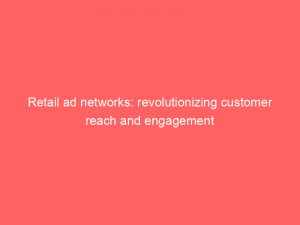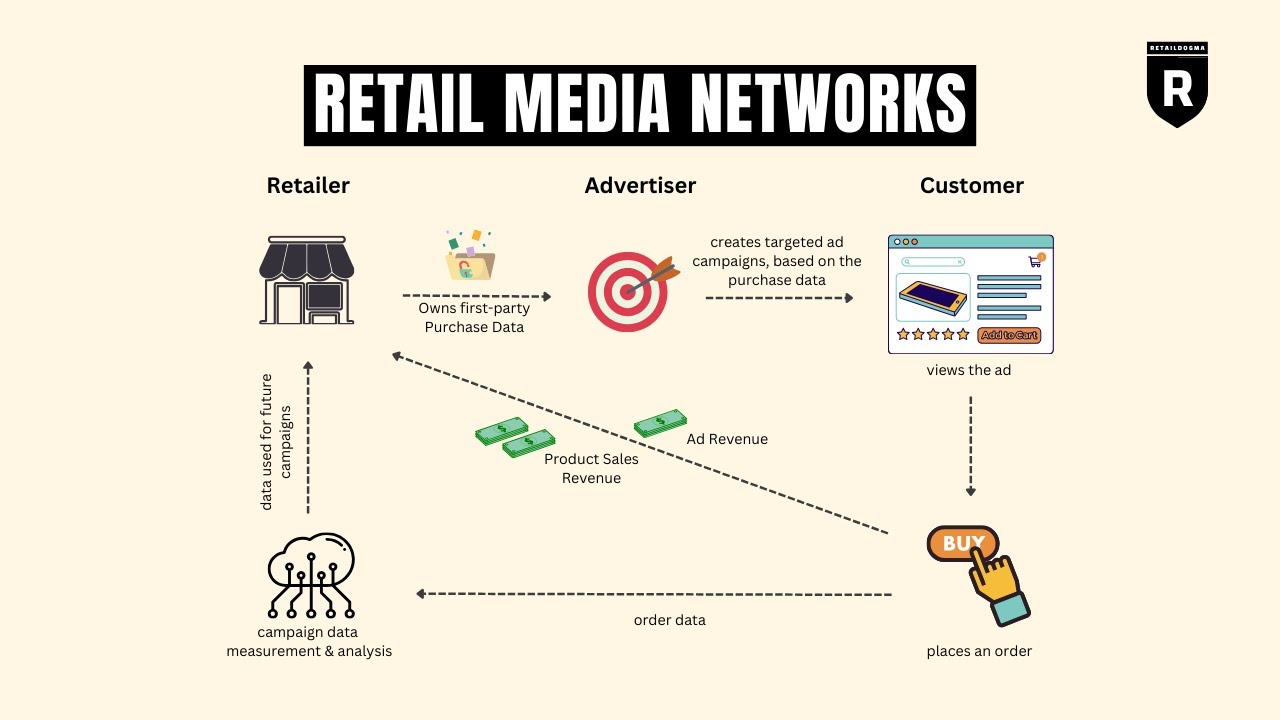- retail ad networks
- Retail Media Networks Increase Brand Visibility To Shoppers
- Advertising On Retailer Websites/App Enhances Relevance For Consumers
- First-Party Insights Gathered From Retail Media Engagement
- Cpg Brands Prioritize First-Party Insights And Retail Media Partnerships
- Increased Investment In Retail Media Networks By Non-Cpg Advertisers
- Brands Develop Internal Operations To Manage Retail Media Advertising
- Expansion Of Retail Media Networks By Major Retailers
In the ever-evolving world of retail, harnessing the power of technology and innovation is key to success. Enter retail medianetworks – the game-changers of advertising.
These networks have revolutionized the way brands connect with shoppers, dive deep into customerinsights, and unlock untapped potentials. Imagine a world where retail giants like Kroger, Best Buy, Macy’s, Albertsons, and Lowe’s not only assist you in finding the perfect product but also offer a platform to amplify your brand’s message.
With the help of third-party solutions, these retail adnetworks have paved the way for endless possibilities and heightened investment opportunities. Prepare to dive into the realm of retail media networks, where big dreams meet even bigger returns.
| Item | Details |
|---|---|
| Topic | Retail ad networks: revolutionizing customer reach and engagement |
| Category | Ads |
| Key takeaway | In the ever-evolving world of retail, harnessing the power of technology and innovation is key to success. Enter retail media networks – the game-changers of advertising. |
| Last updated | December 27, 2025 |
retail ad networks
Retail ad networks are a growing trend in the advertising industry. This form of advertising allows brands to reach consumers through a retailer’s media network, increasing visibility to shoppers.
Advertising on a retailer’s website or app is particularly effective as it makes the ads feel more relevant to consumers. Additionally, brands can gather valuable first-party insights when shoppers engage with retail media or make purchases.
This is especially important for consumer packaged goods (CPG) brands, who are increasingly recognizing the value of first-party insights and partnering with retail media networks. In fact, 75% of non-CPG advertisers are planning to increase their investment in retail media networks.
As a result, brands are building internal operations to manage advertising across different retail media networks. Retailers like Kroger and Best Buy are expanding their retail media networks, while others like Albertsons and Lowe’s are developing their own media offerings.
Updated for the new year’s advertising best practices.
These retailers are making strategic hires and partnerships to ensure the success of their ad solutions, with Albertsons focusing on respecting consumer privacy and Lowe’s launching its own One Roof Media Network in collaboration with CitrusAd, Criteo, and consultancy Franklyn West. The success of retail ad networks is further demonstrated by TripAdvisor, who has effectively measured the impact of advertising on its site, and Macy’s, who manages its media business in-house for multiple advertisers.
Overall, retail ad networks offer brands a valuable opportunity to connect with consumers and gather insights in a relevant and effective manner.Key Points:
- Retail ad networks are a growing trend in the advertising industry and provide brands with increased visibility to shoppers through a retailer’s media network.
- Advertising on a retailer’s website or app is effective in making ads feel more relevant to consumers, resulting in a higher engagement rate.
- Consumer packaged goods (CPG) brands recognize the value of first-party insights and are increasingly partnering with retail media networks.
- 75% of non-CPG advertisers are planning to increase their investment in retail media networks.
- Retailers like Kroger and Best Buy are expanding their retail media networks, while others like Albertsons and Lowe’s are developing their own media offerings.
- Strategic hires and partnerships are being made by retailers to ensure the success of their ad solutions, with a focus on consumer privacy and collaboration with other companies such as CitrusAd, Criteo, and consultancy Franklyn West.
Sources
https://advertising.amazon.com/blog/retail-media-networks
https://adage.com/article/marketing-news-strategy/rise-retail-media-networks-and-implications-agencies/2376136
https://www.forbes.com/sites/jasongoldberg/2022/02/28/retail-media-networks-are-one-of-the-most-important-trends-of-2022-but-they-need-to-evolve/
https://www.bain.com/industry-expertise/retail/retail-media-networks/
Check this out:
💡 Pro Tips:
1. Retail ad networks offer an opportunity for brands to target and reach a specific audience of shoppers who are already engaged with a particular retailer.
2. By advertising on a retailer’s website or app, brands can create a sense of relevancy and trust with consumers, as the ads are seamlessly integrated into the shopping experience.
3. Utilizing retail media allows brands to gain valuable first-party insights and data when shoppers interact with their ads or make purchases, providing valuable information for future marketing strategies.
4. While consumer packaged goods brands are leading the charge in recognizing the significance of first-party insights, non-CPG advertisers are also increasing their investment in retail media networks, with 75% planning to further invest.
5. Many brands are developing internal operations specifically to manage advertising across different retail media networks, allowing for better control and optimization of their marketing efforts.
Retail Media Networks Increase Brand Visibility To Shoppers
In today’s competitive retail landscape, brand visibility is crucial for success. Retail media networks have emerged as a powerful tool for brands to increase their visibility to shoppers.
By advertising on a retailer’s media network, brands can tap into the vast audience that visits these platforms regularly. This provides an opportunity for brands to showcase their products and services directly to consumers who are actively engaged with the retailer’s website or app.
One of the key advantages of advertising on a retailer’s platform is the relevance it brings to consumers. When consumers see advertisements on a retailer’s website or app, they feel that these ads are tailored specifically to them and their interests.
This creates a more personalized and engaging experience, enhancing the chances of consumers taking action on the ads, whether it’s making a purchase, signing up for a newsletter, or exploring more about the brand.
Advertising On Retailer Websites/App Enhances Relevance For Consumers
Advertising on a retailer’s website or app goes beyond just placing ads in front of consumers. It allows brands to leverage the retailer’s data and insights to deliver targeted and relevant ads.
By tapping into the retailer’s understanding of consumer behavior, demographics, and preferences, brands can create advertisements that resonate with the target audience.
This increased relevance is a win-win for both brands and consumers. Brands get to showcase their offerings to a highly targeted audience, while consumers are presented with advertisements that align with their interests and needs.
This creates a more seamless and enjoyable shopping experience, as consumers are more likely to engage with ads that are relevant to them.
Brands also benefit from gathering first-party insights when shoppers interact with retail media or make purchases. These insights provide invaluable information about consumer behavior, preferences, and purchase patterns.
By analyzing this data, brands can refine their marketing strategies, refine their offerings, and enhance their overall customer experience.
First-Party Insights Gathered From Retail Media Engagement
When consumers engage with retail media or make purchases, brands have the opportunity to gather first-party insights. First-party data refers to information collected directly from users, such as their browsing behavior, purchase history, and demographic information.
This data is highly valuable as it provides a deeper understanding of the target audience.
By analyzing first-party data, brands can uncover key insights about consumer preferences, buying habits, and interests. This information can be used to create highly targeted advertising campaigns, personalized marketing messages, and improve overall customer engagement.
First-party insights also enable brands to drive customer loyalty by delivering relevant content and offers.
Consumer packaged goods (CPG) brands have recognized the importance of first-party insights and are increasingly partnering with retail media networks. These networks provide a unique opportunity for CPG brands to gather valuable data directly from shoppers, enabling them to refine their marketing strategies and enhance their competitive advantage.
To accommodate the growing demand for first-party insights, brands are building internal operations to manage advertising in different retail media networks. This allows brands to have more control over their advertising campaigns, ensure consistent messaging across channels, and optimize their overall marketing efforts.
By managing their advertising internally, brands can also build stronger relationships with retailers and negotiate more favorable terms for their ad placements.
Cpg Brands Prioritize First-Party Insights And Retail Media Partnerships
The importance of first-party insights is not lost on CPG brands. They understand that in order to remain competitive in the retail landscape, they need to have a deep understanding of their target consumers.
By gathering first-party insights through retail media engagement, CPG brands can better tailor their marketing strategies, product offerings, and overall customer experience.
With the increasing recognition of the value of first-party insights, CPG brands are prioritizing partnerships with retail media networks. These partnerships enable CPG brands to tap into the vast audience that retailers have access to, while also gaining valuable data that can drive their marketing efforts.
By collaborating with retail media networks, CPG brands can reach their target consumers more effectively and efficiently.
Increased Investment In Retail Media Networks By Non-Cpg Advertisers
While CPG brands have been at the forefront of recognizing the importance of retail media networks, non-CPG advertisers are also realizing the potential of these platforms. According to recent data, 75% of non-CPG advertisers plan to increase their investment in retail media networks.
The growing interest from non-CPG advertisers can be attributed to the success and effectiveness of retail media networks. These platforms offer a unique opportunity for brands to reach a highly engaged audience and deliver targeted advertisements.
As non-CPG advertisers witness the impact of advertising on retail media networks, they are eager to invest further in these platforms to drive their own business growth.
Brands Develop Internal Operations To Manage Retail Media Advertising
As the demand for retail media advertising grows, brands are investing in building internal operations to manage their advertising across different retail media networks. This shift allows brands to have more control over their advertising campaigns, optimize their targeting strategies, and ensure consistent messaging across channels.
By managing their advertising in-house, brands can also establish closer relationships with retailers. This allows for more collaborative efforts and opens the door for negotiation of better ad placements and terms.
Additionally, brands can leverage their internal expertise and resources to monitor campaign performance, make data-driven decisions, and optimize their overall marketing efforts.
Expansion Of Retail Media Networks By Major Retailers
In response to the increasing demand for retail media advertising, major retailers like Kroger and Best Buy are expanding their retail media networks. By enlarging their advertising offerings, these retailers are able to attract more brands and provide a wider array of advertising opportunities.
For instance, TripAdvisor has successfully measured the impact of advertising on its site, proving the effectiveness of retail media networks. This success has prompted other retailers, like Albertsons and Lowe’s, to develop their own media offerings.
Albertsons has even hired a professional to grow its ad solution while respecting consumer privacy.
Lowe’s, on the other hand, has launched the One Roof Media Network and is working with partners such as CitrusAd, Criteo, and consultancy Franklyn West. This collaboration enables Lowe’s to deliver targeted advertisements to its customers, enhancing the relevance and effectiveness of their advertising efforts.
In conclusion, retail media networks are revolutionizing customer reach and engagement in the retail industry. Brands can leverage these networks to increase their visibility to shoppers, deliver personalized and relevant advertisements, and gather valuable first-party insights.
The growing recognition of the importance of retail media networks by both CPG and non-CPG advertisers is leading to increased investment and the development of internal operations to manage advertising. Major retailers are also expanding their media networks, further fueling the effectiveness and potential of retail media advertising.
Native Ad Network • Self-Serve DSP Platform • Buy Traffic • Performance Marketing Tips











